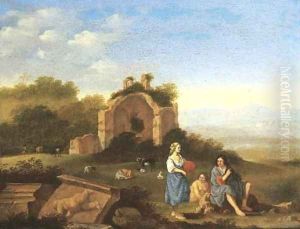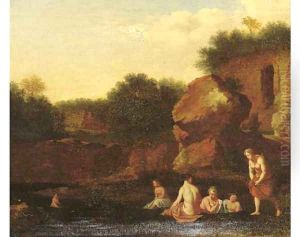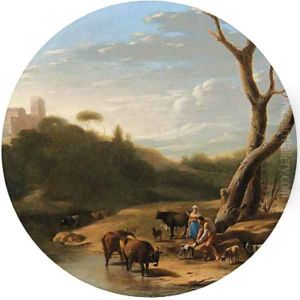Cornelis Poelenburgh Paintings
Cornelis van Poelenburgh, born in 1594 in Utrecht, the Netherlands, was a notable Dutch landscape painter whose works were heavily influenced by the Italianate style. He was among the first Dutch artists to infuse his landscapes with a classical and Arcadian atmosphere, which was a result of his extensive travels to Italy early in his career.
After studying in his hometown under Abraham Bloemaert, a prominent Dutch Mannerist painter, Poelenburgh set out on his Italian journey, which was a customary rite of passage for many Northern European artists at the time. He stayed in Italy for several years, mainly in Rome, where he became associated with the group of Northern artists known as the 'Bentvueghels,' a society that fostered the exchange of ideas and techniques among artists from the Netherlands and Flanders who were living in Rome. His time in Italy had a profound impact on his artistic style, as he absorbed the light, palette, and classical themes prevalent in the works of Italian masters.
Poelenburgh's landscapes typically depict mythological or biblical scenes set in idyllic and pastoral settings. His paintings are characterized by their small scale, meticulous attention to detail, and the delicate rendering of figures, which he often painted with graceful poise and in elegant, flowing drapery. His landscapes also reflect a keen observation of nature, with carefully depicted foliage and a masterful use of light to create a warm, inviting atmosphere. Poelenburgh was particularly admired for his ability to paint marble and his depictions of ruins, which he rendered with great accuracy and charm.
Upon his return to Utrecht in the 1620s, Poelenburgh's Italianate landscapes found favor with collectors, and he became a highly successful artist. His works were sought after by patrons across Europe, including royalty, which led to commissions from the courts of Denmark and Sweden. His influence was considerable, and he trained a number of pupils who carried on his style, contributing to the spread of the Italianate landscape genre in Dutch art.
Poelenburgh continued to paint and enjoy success until his later years. He passed away in 1667, leaving behind a legacy that had a lasting impact on Dutch landscape painting, bridging the gap between the Northern European tradition and the classical landscapes of Italy. His oeuvre captures the harmonious blend of natural beauty and classical antiquity that was so admired by his contemporaries and continues to be appreciated by art historians and collectors today.


